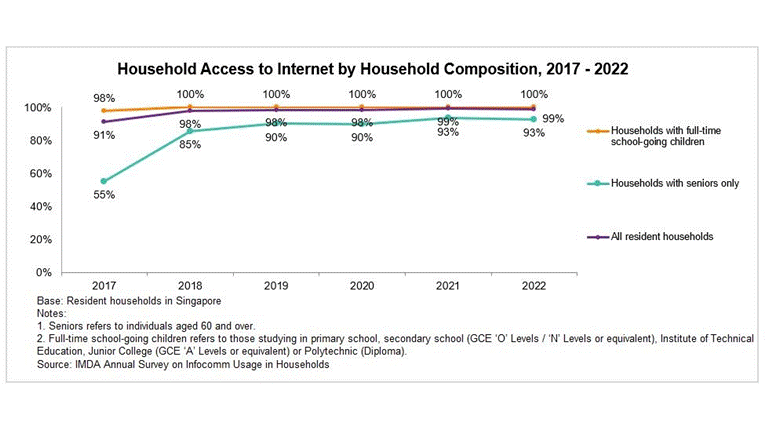Fastest Internet Speed in the World & NGNBN: Singapore's Broadband Journey
There's much more to our NGNBN than just faster broadband speeds. Hop in and learn about its role in boosting home access, remote work and digital adoption.
📊 Key Broadband Stats at a Glance
🚀 277.57 Mbps: Singapore's average fixed broadband speed (March 2024)
📈 8% increase in home broadband access (2017–2022)
👵 55% → 92%: Broadband adoption among senior households
💻 49.3% of the workforce transitioned to work-from-home during COVID-19
🌟 10Gbps speeds targeted islandwide by 2030
📶 Average Internet Speed in Singapore
Earlier this March, research firm Statista updated its rankings for countries with the fastest fixed average broadband speeds.
Singapore has consistently ranked among the world's top nations for internet speed - boasting an impressive average of 277.57 Mbps.
This achievement is largely thanks to the robust infrastructure provided by the Next Generation Nationwide Broadband Network (NGNBN), a project that has redefined connectivity across the island.
🌍 Top 10 Countries with Fastest Internet Speed
| Country | Download Speed |
| United Arab Emirates |
291.85 Mbps |
| Singapore | 290.86 Mbps |
| Hong Kong | 277.26 Mbps |
| Chile | 263.89 Mbps |
| United States | 243.1 Mbps |
| Thailand | 231.86 Mbps |
| Iceland | 226.28 Mbps |
| France | 226.21 Mbps |
| Denmark | 219.44 Mbps |
| Spain | 207.90 Mbps |
🏆 Fastest Internet Speed in the World
While Singapore leads globally in consumer broadband, the fastest internet speed ever recorded is on an entirely different scale.
🌟 World Record: 402 Terabits per Second (Tbps)
- Achieved by: Researchers at Japan's National Institute of Information and Communications Technology (NICT).
- Speed Comparison:
- 402 Tbps is 1.5 million times faster than the average U.S. broadband speed of 226 Mbps.
- At this speed, you could download 12,500 full-length movies in just one second!
- How It Was Achieved:
- Researchers used commercially available optical fiber—the same type used in current broadband infrastructure.
Such speeds demonstrate the potential of advanced fiber-optic technology and what the future could hold for global internet connectivity.
🛠️ What is the Next Generation Nationwide Broadband Network (NGNBN)?
The Next Generation Nationwide Broadband Network (NGNBN) is a groundbreaking project that has transformed Singapore’s digital landscape. Spearheaded by the Infocomm Media Development Authority (IMDA), the NGNBN was a key initiative under the Intelligent Nation 2015 master plan.
A Vision for High-Speed Connectivity
Launched in 2009 and completed in 2014, the NGNBN was designed to provide high-speed broadband access to every household and business in Singapore. This ambitious infrastructure project aimed to ensure that Singaporeans had access to fast and reliable internet, a vital component for supporting economic growth, digital innovation, and smart nation initiatives.
Recognizing Excellence in Engineering
In recognition of its achievements, the NGNBN was awarded a Top 50 placing in the Engineering Feats@IES-SG50 competition in 2016, highlighting its role as one of the country’s most impressive engineering feats.
Future Goals: 10Gbps Speeds by 2030
Since its completion, the NGNBN has continued to evolve. In February 2024, during his Budget speech, then-Deputy Prime Minister Lawrence Wong emphasized the importance of upgrading Singapore’s connectivity infrastructure to meet the needs of the future. The government has set a goal to provide speeds of up to 10Gbps islandwide by 2030.
This upgrade is part of Singapore’s broader strategy to:
- Support the development of artificial intelligence (AI), which requires ultra-fast internet speeds for data processing and communication.
- Enhance connectivity for all Singaporeans, ensuring that everyone, from businesses to individuals, can leverage digital technologies for work, education, and entertainment.
👉 Learn more: IMDA’s Official Fact Sheet
🔍 How has the NGNBN Transformed Singapore?
1. 📈 Home Broadband Access Increased by 8% (2017–2022)
In the past five to seven years, Singapore has seen significant improvements in home broadband access, largely driven by the Next Generation Nationwide Broadband Network (NGNBN). This infrastructure upgrade has allowed more Singaporeans to enjoy faster internet speeds and access to advanced technologies like XGSPON and WiFi 7.
Between 2017 and 2022, the Infocomm Media Development Authority (IMDA) recorded an 8% increase in broadband access, rising from 91% to 99%. Notably, senior citizen-only households (those with individuals aged 60 and above) experienced the most significant growth, jumping from 55% to 92%.
While an 8% increase may seem modest, it's important to consider that Singapore’s population grew by about 300,000 people during this period, and the COVID-19 pandemic also influenced the demand for home connectivity. While the NGNBN wasn’t the only factor at play, it undoubtedly contributed to this positive trend in broadband access.
2. 💻 Smoother Work-from-Home (WFH) transitions during COVID-19
As the pandemic reshaped work environments globally, Singapore was no exception. By 2020, 49.3% of the workforce was working remotely, a major shift that brought about both challenges and opportunities.
The presence of the Nationwide Broadband Network played a crucial role in making that transition smoother. While some businesses faced challenges due to the nature of their work, accessing the Internet from home - provided you had a work laptop or desktop - was probably not an issue for most employees.
Our strong broadband infrastructure provided the foundation for this shift:
- Easy access to online clouds and shared folders
- Seamless virtual meetings and communications
This relatively streamlined transition helped businesses and employees adapt to WFH models faster than in many other countries. Of course, it still took some getting used to for everyone!
3. 👵 66% of Seniors Appreciate Digital Technology
Broadband access has not only benefited the workforce but also transformed how seniors engage with technology. According to the 2023 Singapore Digital Society Report by IMDA, 66% of senior citizens (aged 60 and above) reported that digital technology has significantly improved their quality of life.
The NGNBN has made it easier for seniors to connect with family and friends via video calls, access essential services online, and enjoy entertainment, information, and even food delivery - all from the comfort of their homes. This growing appreciation of digital technology highlights the broader societal benefits of high-speed broadband, extending well beyond the younger population.
👉 Learn more: Singapore Digital Society Report
However, the same report also highlights a potentially larger concern – only 51% of Singapore’s general population (aged 15 and older) are ready to accept the risks that often accompany technological advancements.
As Singapore continues to embrace new digital technologies, the increasing number of online threats and the lack of technical know-how among some segments of the population have raised concerns about the risks associated with these developments. With the upcoming 10Gbps-capable Nationwide Broadband Network, it's vital to address this wariness. Ensuring that everyone is equipped with the right knowledge and tools to navigate this evolving digital landscape is crucial for maintaining a safe, secure, and connected society.
🚀 Singapore’s Broadband Future
As 10Gbps broadband speeds become a reality, it’s important for all Singaporeans to take proactive steps towards embracing the future of connectivity.
✅ Equip yourself with knowledge about technologies like XGSPON and WiFi 7.
✅ Understand your broadband needs to make better decisions for your household.
✅ Educate your loved ones to stay informed and reduce online risks.
By taking these steps, we can unlock the full potential of Singapore's next-generation broadband while ensuring that we and our families remain safe and connected in an increasingly digital world.


 Back
Back







